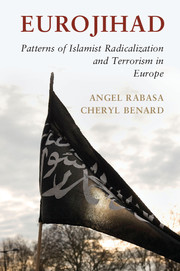Book contents
- Frontmatter
- Contents
- List of figures
- List of tables
- Preface
- Acknowledgments
- List of abbreviations
- 1 Introduction
- 2 Europe’s Muslim Populations
- 3 Salafism and Radical Islamism in Europe
- 4 Origins of Radical Islamist Networks in Europe
- 5 Radicalization Patterns
- 6 Radicalization and Recruitment Nodes
- 7 Evolution of Radical Networks in Europe
- 8 Terrorist Operations and Tactics
- 9 New European Approaches
- 10 Key Judgments
- Bibliography
- Index
- References
2 - Europe’s Muslim Populations
Published online by Cambridge University Press: 05 November 2014
- Frontmatter
- Contents
- List of figures
- List of tables
- Preface
- Acknowledgments
- List of abbreviations
- 1 Introduction
- 2 Europe’s Muslim Populations
- 3 Salafism and Radical Islamism in Europe
- 4 Origins of Radical Islamist Networks in Europe
- 5 Radicalization Patterns
- 6 Radicalization and Recruitment Nodes
- 7 Evolution of Radical Networks in Europe
- 8 Terrorist Operations and Tactics
- 9 New European Approaches
- 10 Key Judgments
- Bibliography
- Index
- References
Summary
The nature of the radical Islamist presence in every European state is specific to the particular demographics of each country. There are also significant variations in the composition of European Muslim communities. “Muslim,” in Europe, denotes ethnicity as well as religion. As Jytte Klausen notes, individuals balance this in different ways. For some, faith is the key source of identity. For others, faith takes a backseat to origin.
Because the availability of data on religious identification varies by country, determining the total number, much less the composition, of Muslim communities in Europe is difficult. Nevertheless, a conservative estimate is that at least 17 million Muslims live in the countries that constitute the European Union, with some sources estimating higher numbers still. Regardless of the source one uses to estimate the number of Muslims in Europe, there is a broad consensus on the nations where these populations are most concentrated. These nations include France, Germany, the United Kingdom, the Netherlands, Belgium, Italy, and Spain. The Muslim population in each of these nations varies in its composition. Generally, the ethnic composition of these populations reflects historical ties between their countries of residence and their home countries or their geographic proximity, as in the case of Spain and Morocco.
- Type
- Chapter
- Information
- EurojihadPatterns of Islamist Radicalization and Terrorism in Europe, pp. 8 - 22Publisher: Cambridge University PressPrint publication year: 2014
References
- 1
- Cited by



